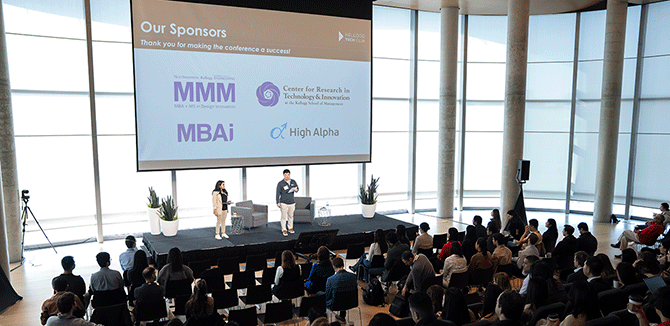A “Techtonic” Shift
The co-chairs of the Kellogg Tech Conference relied on their MBA + MS Design Innovation (MMM) program foundation to create a sold-out event examining the technology industry as it stands at a crossroads.

Bei Dai (MMM '24) and Chaitra Subramaniam (MMM '24) were both excited by the massive challenge in front of them.
They needed to organize a top-tier conference highlighting the latest innovations from the tech industry, featuring standout speakers who would draw a sell-out crowd. They had to do this while keeping up with their work in Northwestern's MBA + MS Design Innovation (MMM) program — a dual-degree program between Northwestern Engineering and the Kellogg School of Management.
How did they do it?
By using the approach taught by the MMM program itself – human-centered design. This theory holds that the best way to create the most useful products and services – and, apparently, conferences – is to start with the end-user in mind and focus first on uncovering their pain points.
“You need to understand your customer, who the audience is, what they might be looking for, and design backward from that,” said Dai, who, along with Subramaniam, served as co-chairs of the Kellogg Tech Conference. “We both found it very satisfying to have it end in this pinnacle experience.”
That pinnacle experience was a sell-out crowd of roughly 400 attendees. This year's conference theme was “Techtonic Shifts.” The play on words illustrated how the tech industry is at a crossroads. New offerings such as artificial intelligence (AI) are changing the sector and the world, yet tech companies are struggling to survive and thrive in this new frontier.
“The idea was to explore this very interesting paradox that we are seeing in the world where you have a lot of hype and attention around new technologies like generative AI," Dai said, "but also simultaneously a downturn in the tech market from an economic perspective and how companies navigate both.
Dai and Subramaniam led a team of about 20 students to organize the conference. They implemented the human-centered design approach to come up with everything from the conference’s theme to the array of speakers.
The roster of speakers included executives from companies like Adobe, Google, Microsoft and OpenAI who hold jobs at the forefront of the tech revolution. Keynote topics touched on generative AI, building an AI business, and how big tech companies think about future-proofing.
Subramaniam said one of the strengths of the conference was that not all speakers were saying the same thing.
“One of them spoke about, ‘Yes, AI needs to be built together. We need co-development,’” she said. “And then the second speaker said, ‘No, that's not always the best way forward. Building an AI business sometimes needs to have protection and you need to be thinking about data privacy, so not everything can be built together.’ You really need to think through the use cases and what’s really right for you and your business.”
There again was the MMM tenet of human-centered design coming into play, Dai and Subramaniam said.
Both co-chairs said they were thrilled with how the conference turned out, and that it wouldn’t have been so successful had they not had their foundation built through the MMM program.
“The core lesson of MMM is to understand your user, understand who you're designing for,” Dai said. “There was a lot of thought put in about who our audience is going to be and what types of personas are going to be attending in terms of what they're trying to get out of it. That kind of mindset very much ties to MMM.”
